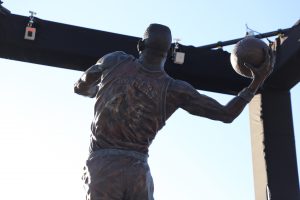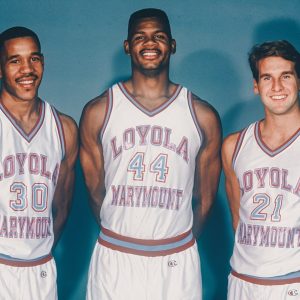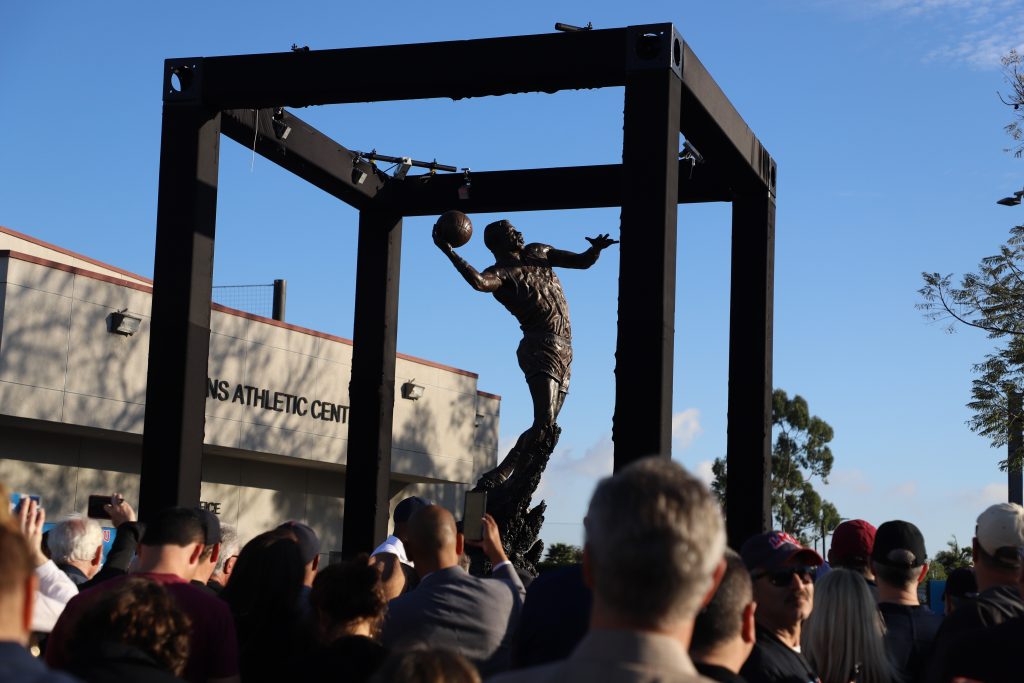It was just a moment. It came after the blousy material dropped to reveal a statue of basketball legend Hank Gathers, located just outside of Loyola Marymount’s Gersten Pavilion Feb. 29. It came after the faintest beat of a gasp was immediately followed by applause and cheers, broad smiles and — this being 2020 — selfies.
Still, there was a moment when, Chris Knight said, amid the laughter and hugs he shared with former teammates who played with Gathers, that he suddenly, in a fleeting space of silence, “could hear Hank’s mother crying above it all.”
Lucille Gathers was at the dedication of her son’s statue, accepting and giving as many hugs as anyone present. The statue is magnificent, which is not a given in the sports world. More than a few have been found lacking when it comes to representing their subjects accurately in visage, temperament or action.
But the Gathers statue not only looks like Gathers, but depicts him perfectly. Created by the Fine Art Studio of Rotblatt-Amrany — the same outfit that created statues of Kareem Abdul-Jabbar, Magic Johnson, and Jerry West at Staples Center and Michael Jordan inside Chicago’s United Center — it shows Gathers in all his basketball glory, at the point of takeoff, about to slam a defenseless basketball, which he palms like a loaf of bread, his jersey rippling from the ferocious hallmarks of his game: speed and power.
It was those hallmarks that moved his LMU coach, Paul Westhead, to say, “There was nothing ordinary about Hank Gathers. He was a walking thunderbolt.”

Westhead’s words were so apropos that they are inscribed on the statue’s base. It was those hallmarks that made Gathers’ death on court during a game in 1990 incomprehensible; that someone so young, so strong, so able, so beloved, could be taken so suddenly.
It was something that Gathers’ former teammates grappled with when he passed. They were young men, then. For many, this was the first time they had encountered death with someone close to them, certainly with someone their own age.
That wasn’t true of Knight. Raised in South Central LA, he said he was no stranger to young men dying. But, he said, “It was always for people who were doing things they should not have been doing. Hank did nothing wrong. Nothing. He didn’t even drink.”
Like Knight, who replaced Gathers in the LMU lineup, a lot of the players spoke about Gathers’ passing as teaching them that life and death, often referred to as opposites, actually exist intertwined and in constant relation to each other.
Most of them are approaching or in their 50s now, and seeing the Gathers statue in all of its strength and vitality reminded them also of life’s quicksilver nature and why it must be cherished.
More than one mentioned Kobe Bryant’s recent passing as another reminder of that. Tom Peabody, a guard on the 1989-90 team, said that learning of Bryant’s death gave him the same feeling as when his friend passed.
“It’s the first time I’ve felt like that in 30 years,” he told the Los Angeles Times.
Jeff Fryer, a record-setting shooting guard on the team, had a 10-year professional basketball career, but it was one that gave him very little joy. Suffering from depression and anxiety, he had gone to a place of darkness, he said, one he wasn’t sure he wanted to ever leave. It was thinking about Hank, he said, that eventually moved him to “get down on my knees and commit myself to God. That was from thinking about Hank; about life and death.”
Fryer said it was thinking about how his teammate and friend had embraced life that made him think about what he was doing with his own. He figured most of his teammates felt the same, which is why, he said, he wasn’t the least bit surprised to see the reaction to Gathers’ statue be so joyful, what Westhead called “unmistakably celebratory.”
“I’ve had a couple people ask me that, if I thought people might be sad or cry, but I knew this is how it would be,” Fryer said. “We’re all so grateful for him, for that time. We’re grateful about the effect it’s had on the rest of our lives. Look at me. If it wasn’t for Hank Gathers, I’m pretty sure I’d be dead.”

Fryer and his teammates were not only present to celebrate Gathers’ statue, but to celebrate the accomplishments of the 1989-90 LMU team that made perhaps the most magical run through the NCAA tournament in the basketball program’s history.
After Gathers’ death, Westhead left it up to his players whether they wanted to compete in the tournament. They said they did, and advanced to the Elite Eight, defeating along the way defending champion Michigan, a game in which Fryer made a record 11 3-point shots, yet eventually losing to UNLV, a team considered one of the greatest in NCAA history.
Perhaps the lasting image of that tournament run is of Bo Kimble shooting free throws left-handed as his best friend Hank Gathers had. Kimble attended the ceremony and spoke during a halftime ceremony honoring the team.
Kimble was effusive and joyous in his remarks, telling funny stories and inside jokes. But he made sure to recognize Lucille Gathers sitting courtside, thanking her for the gift of Gathers.
A video released by LMU prior to the unveiling showed Lucille after seeing the statue for the first time. Overcome with emotion, she thanked those who created the statue and those who commissioned it.
“I think about him often,” she said of her son through gentle sobs, “because he was my baby.”
Later in the evening, after LMU had lost a close game to University of San Francisco, people once again gathered around the statue.
The mood this time, in the dark, a spotlight casting long shadows of the statue across nearby buildings, was a bit more somber, one might say contemplative, as people seemed to consider the lessons of Gathers’ life, memories held in the perpetual flash of a thunderbolt.

